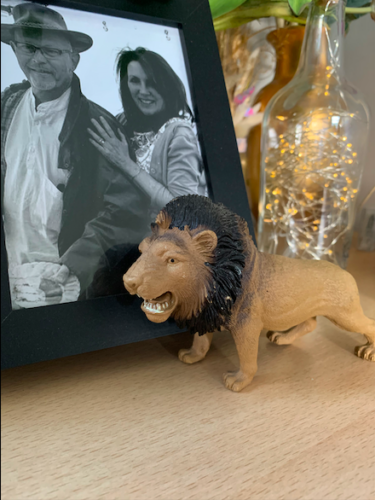Love writ large.
That’s something I heard a passer-by say quietly as they walked along Albert Embankment this week. They were walking along the National Covid Memorial Wall, with tears running down their cheeks. Thousands and thousands of others have walked the 500m length of the wall of 150,000 painted hearts, often stunned into silence at the immensity of this piece of art, created by ordinary, bereaved people and sympathetic volunteers helping us.
I’ve been there all day, nearly every day, for almost two weeks, immersed in an experience that has lifted my soul and my spirits and made me feel alive again amongst strangers. After the long, long, icy isolation of grieving in lockdown, grieving in a pandemic, what these last two weeks have given me is precious beyond words.
On Monday March 29th I took an early train into London and walked along the South Bank towards Lambeth Bridge. The previous week, I had seen a post asking for volunteers to take part in a commemorative art installation that was being planned by the campaign group Covid-19 Bereaved Families for Justice – a group I’d joined after Steve died after struggling alone in hospital for twelve days battling the virus. At the time, I didn’t know what I was signing up for, but as I have all the time in the world now, I thought I might as well offer a few hours to a good cause.
On Friday 26th we had been invited to a confidential Zoom briefing where the details were outlined to us. We were to be part of the creation of the National Covid Memorial Wall, painting a single heart for every single person who has died in the UK with Covid-19 on their death certificates since the pandemic began, along the wall on the South Bank opposite the Houses of Parliament.
The artistic impression was breath-taking, and the power of the messaging, the positioning of this stunning reminder of our immense collective loss was instantly understood. Right in the heart of London, visible to those who are making the decisions about us, decisions that have led directly or indirectly to so many thousands of deaths and the heartbreak of loss.
The legal briefing was sobering – we didn’t have permission to do this, and technically, by painting on a wall as planned, there was a possibility of arrest, particularly on the first day – we could be at risk of being prosecuted for criminal damage, with fines of thousands of pounds and a potential prison sentence. The legal advice that had been received was that this would be an unlikely outcome, given the poor PR that would result from arresting bereaved people creating a commemorative memorial to their dead family members, but still…
I actually remember feeling even more compelled to be involved at this point, there’s a rebellious side to my nature where I see injustice or a cause that I believe in, so, along with everyone else at the meeting, I was undeterred. I committed to doing a shift of three hours on the first, most risky day.
Over the weekend, I let my children know what I was doing and what the outcome could possibly be, and also remembered to tell Jane and Isabel, my fellow executive directors at the GFG – I thought it might not be a good look for the CEO to be arrested without them having prior warning of the possibility, even though I was doing this in my personal capacity and not representing the Good Funeral Guide at all. Everyone was amazingly supportive, although my daughters were obviously a bit concerned.
So, there I was, half an hour early, sitting on a bench looking at the Houses of Parliament waiting for the 08.00 meeting at the assignation point. Gradually people drifted together, a group of perhaps twenty of us gathered by a coffee van, the small number of organisers laying out tabards and branded face masks and handing out paint pens and hand sanitiser – and with a brief instruction of how to get best use of the pens and the size guidelines for the hearts and the importance of social distancing at all times, we were put into small groups, donned our tabards and set off back towards Westminster Bridge to begin painting on the wall.
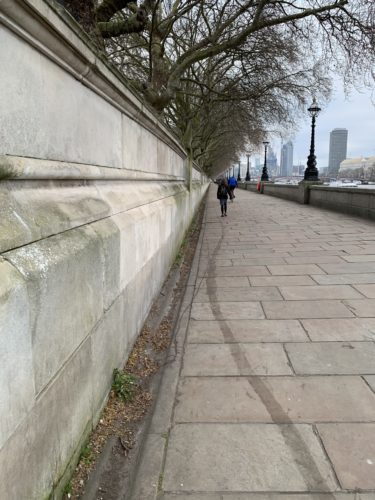
Each group had a section of perhaps 20 metres length of the pale sandstone wall. It’s about 2 metres high. The hearts we had been asked to draw were about 10cm in height. We had 150,000 to do, each one painted for one person, one family. It was important to do each one with reverence and mindfulness of what we were representing.
As I painted the first heart, I felt a brush of air and a strong sense that Steve was close to me at that moment. It was very strange, but it felt like I was doing something really important. For him, for me. I was placing his memory where his name would stay to be seen by thousands of people. I think I cried as I painted. It was very, very emotional.
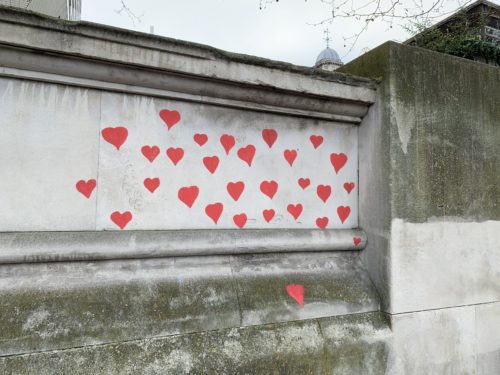
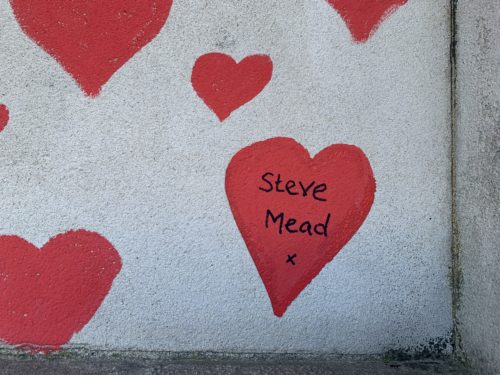
Then, with Steve safely named on the first heart that I drew, I set to work. For others. Alongside me, at a distance, the other volunteers worked quietly. Gradually a scattering of hearts began to gleam on the wall. Quiet conversations began as we worked, the occasional offer of coffee, passers by stopping to ask what we were doing. The organisers had everything set up beautifully, replacement pens were ready when we ran out of paint, boards went up proclaiming this to be the National Covid Memorial Wall, the recently appointed Campaign Manager for the group, Nathan and his lovely Campaign Assistant Clara who was starting her first day in her new job were amazingly supportive and effective, and we worked and worked. As the morning went by, camera crews began to arrive – the pre-event PR had been extraordinarily good, and word was out that something important was happening.
We painted and painted, and gradually talked and talked, to each other, to passers-by, to journalists and presenters and camera crews, to anyone who wanted to know what we were doing and why. I told Steve’s story over and over and saw the shock and sadness in strangers’ eyes when they heard he had become ill the day after we married and died just three weeks after our wedding. And because I was able to speak to cameras about it, Clara asked if it was ok to bring news crews to interview me, and I said of course, and the day began to be filled with journalists from international news stations and newspapers, all asking me about Steve. Politicians came too – first Florence Eshalomi MP, who I was introduced to, then Sir Keir Starmer arrived and met some of the volunteers, voicing his support. Councillor Jack Hopkins, leader of Lambeth Council came on that first day and committed to trying to help make the wall permanent.
My three-hour shift had turned into a whole day, and I was so captivated by the immensity of what we were doing, I promised to go back the next day to help again. And the next, and the next – I cancelled everything I had planned that week and just went back to the wall every day, to help make it happen. It cost me a fortune in rail travel (is there still such a thing as a rush hour? Tickets for the early trains cost 50% more than the ones running after 10am, why on earth is that, during a lockdown?) The later trains were no good, I’d lose three hours painting time. I was on the 06.26 train each day to get me there for 8.
We were desperate for more volunteers, each heart was taking around a minute or so to paint, and at one point one morning there were just three of us, me, Richie and Sophie. But the media coverage was growing. The support from Opposition MPs was growing. The wall was capturing people’s hearts as we painted, and members of the public began offering to help.
As days went by, the wall was news across the world. We had coverage from international news organisation Reuters, articles in US newspapers The New York Times, The Washington Post, French radio (France Inter, France Info and France Culture), Ireland’s RTE, Australian ABC TV – Japanese, German, Czech news teams and so many others too all found their way to talk to me and many of the other volunteers
Here in the UK, The Guardian picked it up on the first day, as did ITV and BBC London news channels early last week, and as time went by we had more and more coverage on our national media. LBC Radio covered it, Sky News covered it, Emily Thornberry MP tweeted a lovely video of her visit which has been viewed almost 40,000 times. On Good Friday we had an early morning live to air piece on BBC Breakfast which I was asked to do, and they showed photos of Steve as I talked. The numbers of volunteers soared after that, and the wall kept growing and growing and the camera crews kept coming, and the politicians came too.
I took the weekend off to do Easter with the family, although it felt strange not to be in London after five days of such intensity. Then on Monday, I went back again and was astounded at the amount of hearts that had appeared over the weekend. I spent the day on the desk, handing out pens and tabards to the steady stream of volunteers who had signed up to help, then planned on having two days off to catch up with work.
It had been exhilarating and extraordinary, and not a little exhausting. We had painted in all weathers, rain, wind, sun and snow, and the days had been long and emotionally draining, even though I had loved being there all the time. But then I had a call on Tuesday afternoon, asking me to come in to do a piece for Newsnight with Emily Maitlis, so I had to quickly change into something suitable for the wind chill along the river and get back to the South Bank.
On top of all the many media channels we’ve had interest from, the extraordinary coverage we received from the BBC in the two pieces that were aired on national TV means that millions of people now know about the wall, and both Charlie Stayt on Breakfast and Emily on Newsnight were so very supportive and kind – generous with time and so gentle in their questions.
The target of 150,000 hearts was reached on Wednesday evening, then the ONS released the latest figures on Thursday morning, so the organisers scrambled to add another several hundred more hearts, to bring the wall up to date before the official ‘Come and Walk the Wall’ ceremony at 12.00.
Having inadvertently become the featured spokesperson for the project, I was asked to talk to the assembled press, and then paint the final three hearts. I can’t remember exactly what I said into the microphone, for the first time speaking to cameras, I felt the emotion welling up and overcoming me at the immensity of what we had done for the hundreds and hundreds of thousands of people who are unseen in their grief. It was overwhelming, and I had to choke back the tears and turn away from the lenses to paint the last hearts.
For the rest of the day on Thursday, I walked along the wall, reading the inscriptions, taking in the huge, huge toll we have paid, tears close to the surface all the time. The messages that had been added to some of the hearts, the names – so, so many names – the heartbreak that had been given a home, a place of honour – to have been part of helping create this was completely humbling.
I was so proud, and so, so sad. Everything that I had said into countless cameras over the previous ten days was absolutely true. We need to see the scale of the horror of what has happened, we need a place where the grief and the loss and the anger can be channelled into a powerful visual rage at our loss. A statement that cannot be ignored by the people in power, across the river in the Palace of Westminster.
On one of the walks, I was accompanying Dawn Butler MP, and halfway along we met London Mayor Sadiq Khan. They were both impacted as much as everyone who has seen the wall, the length of it and the horror of what it represents. Nobody could fail to be moved.
The media coverage of the completed wall on Thursday went across the world, thanks to a piece from the Press Association by Caitlin Doherty – it has been picked up by many, many news outlets, in places as far away as Barbados. It’s a source of tremendous private pleasure to me that Steve has been publicly proclaimed as ‘my husband’, far and wide, to millions and millions of people. Our three weeks of married life were the worst they could possibly be as he succumbed to Covid, apart from me for almost all of the time, but he is forever now my husband. (Just Google ‘Steve Mead news’!). But he is needlessly dead, he shouldn’t have died when he did, in the way that he did.
More than one hundred and fifty thousand people have gone. Vanished. Dead. Before they needed to be. They died, mostly, alone. These hearts that we have painted represent the beating hearts that have stopped. That have been stilled. Every single one a life. A person.
And their bereft families have been grieving alone. I have met some of them during my time at the wall, and we recognise our own pain in each other’s eyes. We know this unique loss, this guilt, this common feeling of being the nation’s guilty secret, the thing everyone needs to move on from, the weight that is stopping everything from really going back to normal, the fleeting thoughts that perhaps we should have done things differently, never called for an ambulance, never let our darling person go to hospital, never had to break a promise to be with someone we loved until the absolute end. We know the raw jolt of pain at hearing the deaths of our beloved fathers, mothers, husbands, wives, sons, daughters, brothers, sisters, cousins, aunts, uncles, grandmothers, grandfathers, our flesh and blood, our kin – described as numbers, statistics by which government action or inaction is judged. We know what it is to grieve for a life lost to a pandemic, to be completely alone, unhinged, unhugged, uncomforted.
A community has grown through our commitment to do this thing – I have met the most wonderful, wounded souls who have a fierce determination that our dead people WILL NOT be brushed away from our nation’s memory. My own grief has been reflected back to me with love and kindness and generosity by people who understand. And we have a determination to work together, to channel this grief we share into a collective good.
I cannot thank enough the two people whose idea this was – Matt and Jo, both bereaved by Covid, the founders of the Covid-19 Bereaved Families for Justice campaign group. And the extraordinary team who helped make it happen – Ollie, James, Nathan, Clara, Veronica, Alex, Dom, Jack and others whose names I am sorry, but I’ve forgotten. Thanks also to London Mayor Sadiq Khan for his support in our quest to keep the wall as a permanent memorial, and to Dawn Butler MP for offering to ask a question in the House of Commons about the government’s support for this aim.
After the long, long, brutal isolation of the winter, it has been a balm to be back among people again. I’ve met so many lovely people over the last two weeks. Wonderful fellow volunteers – particularly Becky and Richie and Sioux who were there so much. Catherine and Sophie and Leena and Karen. I’ve cried as I’ve heard the anguish, the sorrow of the stories I’ve been told. Strangers who stopped to talk, kind passers by offering us money and gratitude and hot chocolate and food. People who travelled from all over the country to come and be at the wall for their dead family member, for themselves, for their grief. Old people, young people, children, dogs. I have been surrounded by people for the first time since Steve’s funeral, and I feel alive again. I’ve spoken so much, to so many people, and I have been privileged to be asked to be the voice and the spokesperson on behalf of all of us who have had someone die from Covid-19.
It has been a profoundly important thing for me to have been involved with, and a healing and cathartic experience that I will always remember. I hope that Steve would forgive me for committing criminal damage – I think he would approve, after rolling his eyes and sighing at my unruly behaviour. He believed in justice, and this wall, this beautiful harrowing wall, is a call for justice. It’s a profound piece of art. It’s soaked in grief and pain and tears. It’s a place of loss, and reflection and community. It’s a living, people’s memorial.
I’m so proud to have been part of it.
NB – To date, no government minister or Tory MP has visited the National Covid Memorial Wall.
Every MP received an invitation to do so, at the start of the first week. Perhaps, when they all come back from their Easter recess, they will all have the decency to walk across Westminster Bridge and turn right to walk along the wall*
*Update 28.04.21 – apparently the Prime Minister visited the wall ‘under cover of darkness’ during the evening of Tuesday 27th April. Helpfully avoiding meeting a single bereaved family.


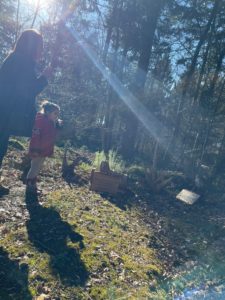

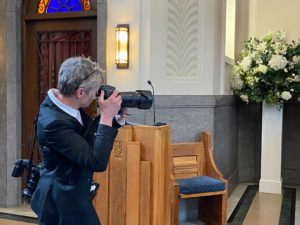

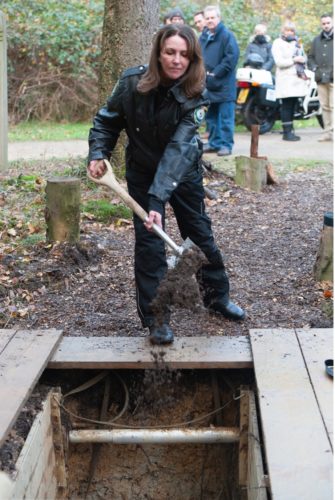 Photo credit: Rachel Wallace Photography
Photo credit: Rachel Wallace Photography